.

How To Grow Weed That Smells Strong And Tastes Superb
Every strain has a unique smell and taste, whether skunky, fruity or anywhere in between. Every grower values huge yields and strong flowers, but nothing quite beats bud, that also smells tempting and tastes delicious.
Contents:
- Terpenes and terpenoids
- Trichomes: the key to better aromas and flavors
- Choose the right genetics
- Apply the right amount of stress
- Use the best nutrients for flavor
- Start with a super soil mix
- Drop temperatures at night
- Use uv light to enhance terpene production
- Flush your plants to improve flower flavor
- Light deprivation
- Harvest your plants at the right time
- Drying and curing
- Flavoring techniques
- Flavorful cannabis: you’re in control
When growing cannabis, some of the key factors cultivators strive towards are massive harvests, that produce buds of high quality. Cannabis consumers also have the potency of buds high up on their priority list, ensuring, that they get the desired cannabinoid quantity and ratio in return for their money. Another large factor that adds character and value to a marijuana harvest is the smell and taste of the product. Many strains have familiar and nostalgic scents and flavors to them, so much so, that the strain is literally named after either the dank smells of cheese, diesel and skunk, or more fruit and vibrant aromas, such as pineapple, blueberry and apple.
One of the first actions somebody commits when they are looking to purchase marijuana, is to shove their nose into the storage bag or jar and take a big lungful of aromatic goodness. Smell and taste are definitely important when it comes to smoking preferences. However, there is so much information out there regarding how to produce colossal harvests and how to ensure your buds are fully frosted with mammoth amounts of cannabinoids. There is no denying the importance of these factors when growing, but taking measures to ensure the optimum outcome in terms of smell and taste for your crop will only add to the overall quality of your harvest.
Terpenes and Terpenoids
The key players in improving the taste and smell of your cannabis are, without a doubt, terpenes and terpenoids. These compounds are formed alongside cannabinoids on small glands of cannabis flowers known as trichomes. Taking direct measures to influence increased production of terpenes and terpenoids will enable you to maximise the scent and taste, that the specific strain you are growing is capable of producing. Each strain will have its own unique smell and taste due to genetic factors. This can be boosted using growing techniques, however it is important to roughly know what smell and taste you are looking to achieve, and then selecting the correct strain in order to attain the desired outcome.
Terpenes and terpenoids are the molecules responsible for the diverse array of scents and flavors spread across many different cannabis strains. They are also found elsewhere in the plant kingdom and are responsible for the familiar smells of lavender, pine, citrus, basil and more. Although they are absolutely key in the domains of scent and taste, it has been found, that they can also influence the type of high a cannabis plant will produce. They have also been found to have vast potential in the field of medicinal cannabis.
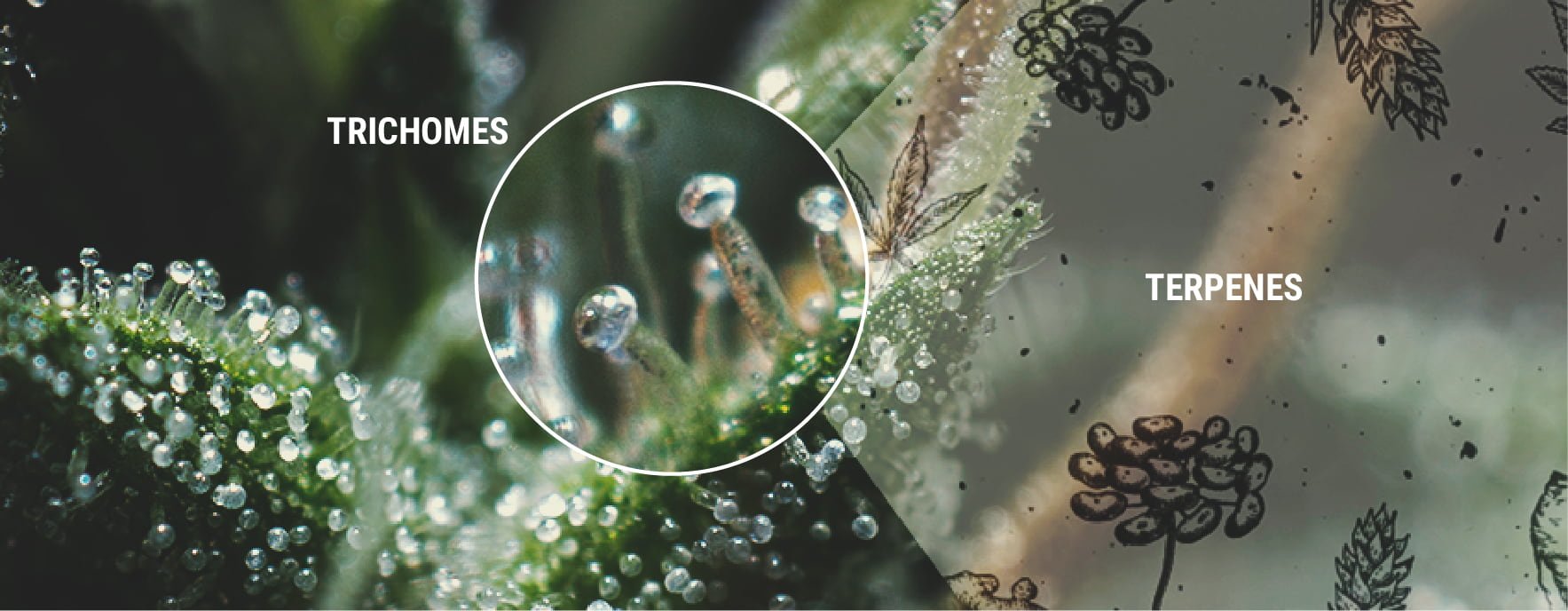
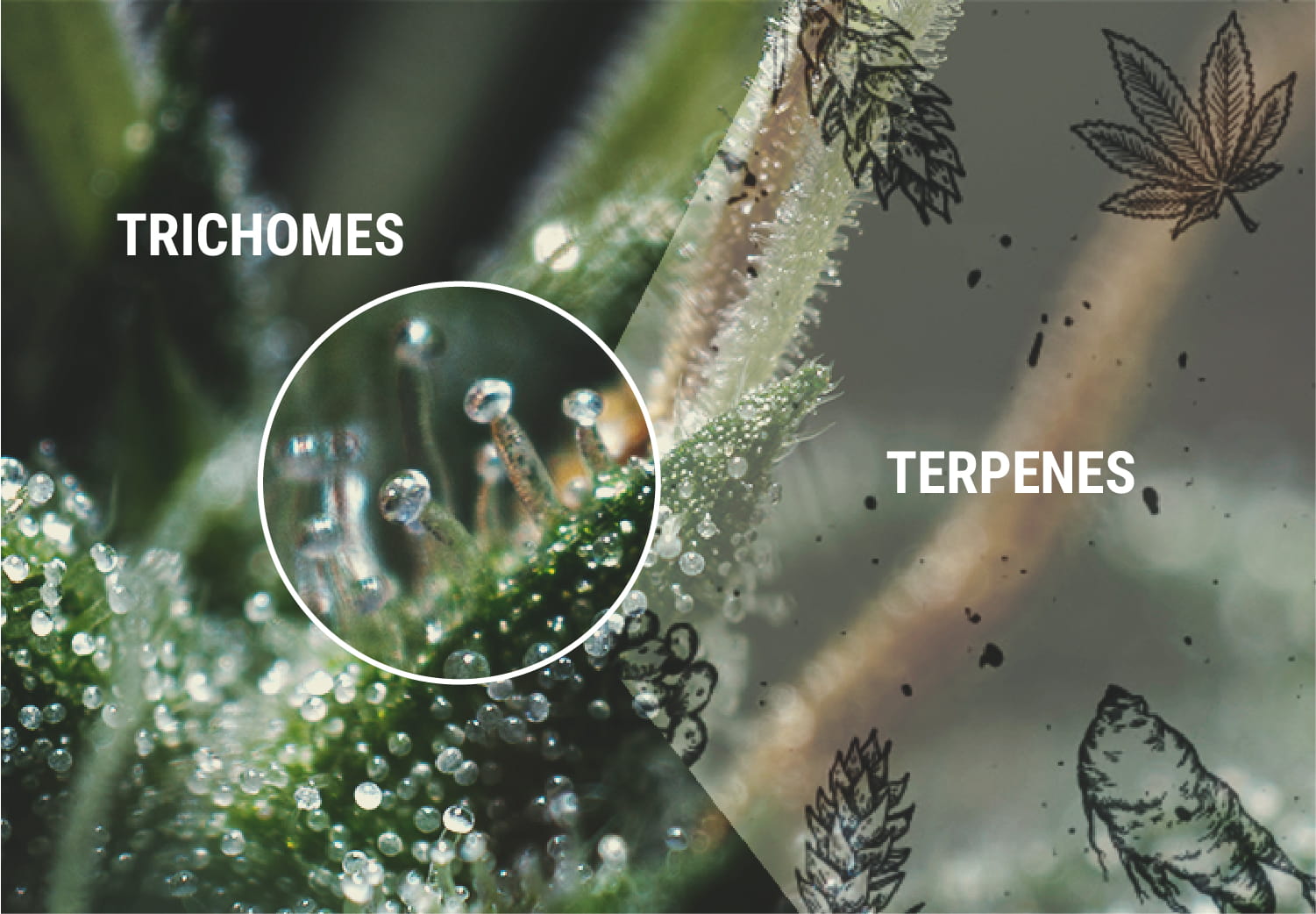
Trichomes: The Key to Better Aromas and Flavors
Growers frequently ask us questions about the best ways to cultivate cannabis. “How to make my weed taste good?” ranks as one of the most common. Luckily, there are a bunch of variables you can tweak to drive terpene production through the roof.
Have you heard of trichomes? These minute glands occupy the surface of cannabis flowers and give them their “frosty” appearance. They spend their days manufacturing cannabinoids and terpenes, churning them out in the form of a viscous resin. Because trichomes make terpenes, it makes sense to do everything possible to maximise trichome production and improve the taste and smell of your buds.
Below, you’ll discover several sure-fire methods to ramp up trichome levels, resulting in mouth-watering flavors and tantalising aromas.
Choose the Right Genetics
Genetics rules the day when it comes to trichome production and terpene profiles. The genotype of a plant pre-determines its key traits, including smell and taste. Some varieties are fruity and sugary, others are floral and earthy, and some are reminiscent of petrol and musk.
Genetics doesn’t just control the type of terpenes produced, but also the amount of these aromatic molecules. Through intentional selection, breeders create varieties that pump out a lot more resin than other cultivars. As this process continues and more hybrids are created, cannabis strains are becoming stickier and stinkier by the year.
If you want to grow the tastiest weed possible, you need to start out with appropriate genetic stock bred for high trichome counts. Of course, you should also select strains based on flavors that you’ll actually enjoy. Check out some examples of terpene-rich varieties from the RQS library:
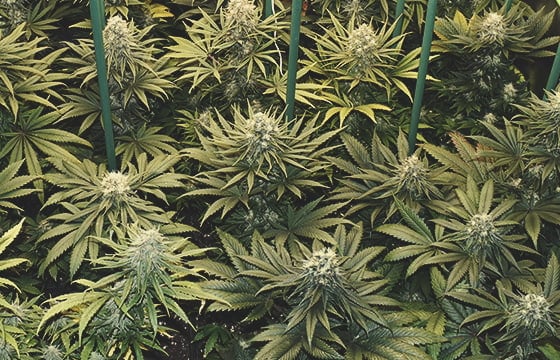 |
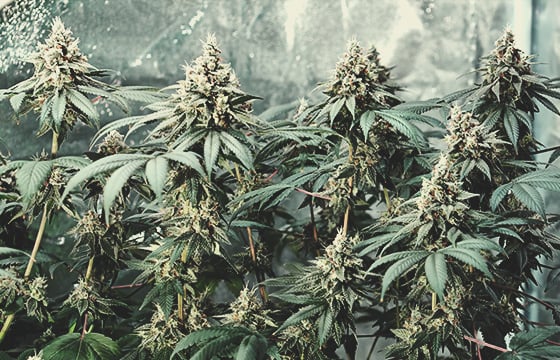 |
 |
| Fruit Spirit: The progeny of Blueberry and White Widow, you won’t catch buds much frostier than these. | Fat Banana: As her name suggests, this indica-dominant hybrid churns out boatloads of tropical terpenes. | Haze Berry: Her dense layers of trichomes secrete THC levels of 20% alongside fruity and earthy terpenes. |
 |
 |
|
| Sherbet Queen: Just take a look at pictures of this strain to see how frosty things can get! Enjoy outrageous THC levels of 24% paired with tastes of candy, citrus, and mint. | Wedding Crasher: Her high trichome concentration adds a shimmering layer to stunning green-purple flowers. Get ready to enjoy unique flavors of fruit and vanilla. |

| Fruit Spirit: The progeny of Blueberry and White Widow, you won’t catch buds much frostier than these. |

| Fat Banana: As her name suggests, this indica-dominant hybrid churns out boatloads of tropical terpenes. |

| Haze Berry: Her dense layers of trichomes secrete THC levels of 20% alongside fruity and earthy terpenes. |
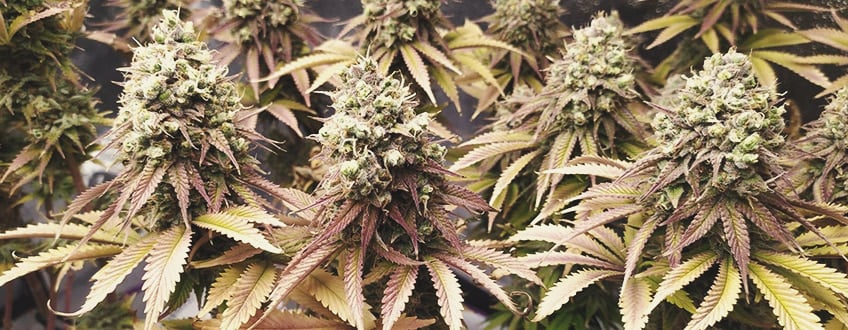
| Sherbet Queen: Just take a look at pictures of this strain to see how frosty things can get! Enjoy outrageous THC levels of 24% paired with tastes of candy, citrus, and mint. |
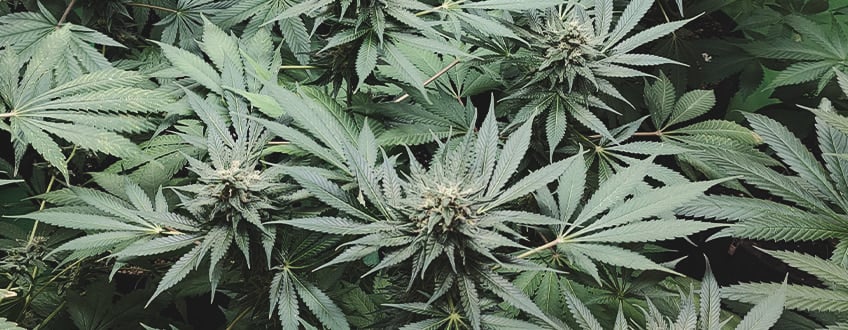
| Wedding Crasher: Her high trichome concentration adds a shimmering layer to stunning green-purple flowers. Get ready to enjoy unique flavors of fruit and vanilla. |
Though genetics forms the cornerstone of growing the tastiest weed possible, tapping into a strain's full potential also involves optimising their growing environment. While genotype refers to the genetic constitution of a cannabis plant, phenotype describes the traits expressed by a plant based on how the genotype interacts with the environment.
By inflicting controlled stress and feeding your plants properly, you can unleash their true genetic potential. Explore the tips below to let the resin flow!
Apply the Right Amount of Stress
Stressing your plants in the wrong ways causes all kinds of trouble, from light burn to overwatering. However, the right amount of stress can actually cause favorable adaptations. In plant science, the term hormesis describes an advantageous response to adverse conditions in which plant performance is upregulated.
Our anthropocentric view of the world can make us view terpenes as something made for human enjoyment. Sure, these phytochemicals taste great and modulate the cannabis high, but they’re actually weapons of war in the plant world. Classed as secondary metabolites, these molecules don’t contribute to growth and reproduction, but instead help to fend off pests and predators.
But cannabis plants don’t just create terpenes haphazardly. After undergoing damage from herbivores, parts of the plant begin to produce defensive terpenes with undesirable tastes to ward off grazing predators. Plants even use terpenes as airborne signals to warn their neighbors of an impending attack[1].
But what does this have to do with growing tasty cannabis at home? Much like you mimic the sun with grow lights and the wind with fans, you can also replicate the stress of herbivores grazing by training your plants. Not only will this boost trichome production, but you’ll enhance structure and productivity while you’re at it. Check out a few popular training techniques below.
-
Low-Stress Training (LST)
Low-stress training involves gently bending plants into the desired position. It doesn’t induce much stress; just enough to make a noticeable difference in trichome production. It poses little risk and does wonders to improve canopy shape and bud uniformity.
Performed early in the vegetative phase, LST is used to force the main stem to grow parallel with the growing medium. This allows the side branches to surge upward and form a dense productive canopy under even light distribution. You can accomplish this armed with only a few garden ties and a small hand drill.

-
Defoliation
Defoliation works as a great complementary training technique to LST. We recommend performing it once during veg and once during flowering. As the name suggests, it involves lopping off fan leaves in a controlled manner—an action that closely mimics the damage inflicted by a herbivorous predator. Defoliation also comes with the added benefits of increased aeration and improved light penetration.

-
Super Cropping
As a form of high-stress training, super cropping takes an experienced and steady hand. The technique involves pinching cannabis branches in a way that makes the inner tissue more malleable, without tearing the outer layers. Done successfully, this makes branches floppy, allowing growers to direct their growth as desired. Super cropping forms beautifully managed canopies that are highly productive, while providing enough stress to send trichome and terpene production into overdrive.

-
Splitting Stems
Splitting stems seems utterly bizarre to the uninitiated, but driving a knife through the main stem during the last week of flowering actually helps to enhance results and ramp up trichome production.

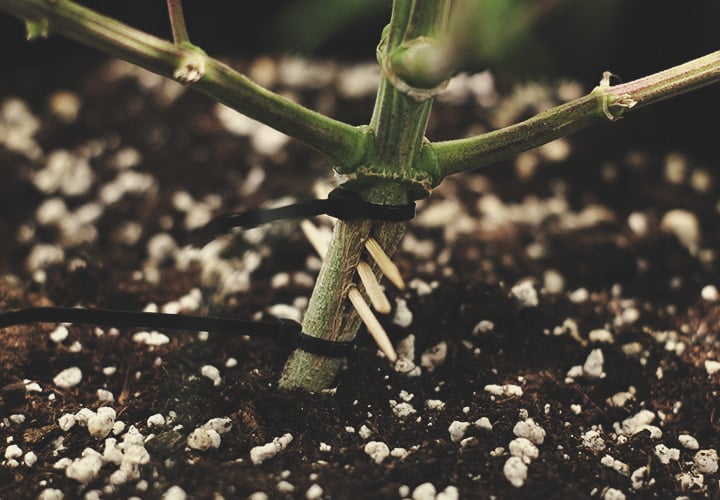
Use the Best Nutrients for Flavor
Growers often come to us exclaiming, “My buds have no taste!”. Sometimes, all it takes is a change in diet to elevate trichome levels to new heights. Add the supplements below to your feeding regimen for buds that will light up your taste buds.
| Molasses | Molasses is a sweet byproduct of sugar processing rich in carbohydrates, calcium, iron, selenium, copper, and magnesium. Molasses feeds beneficial microbes in the soil as well as your plants. Simply add 4–5ml per litre of lukewarm water and apply 1–2 times per week during the vegetative phase. Increase the dose to 8–10ml during the flowering stage. |
| Amino Acids | Amino acids are the building blocks of proteins. They’re vital for energy generation, nutrient transport, and the synthesis of key vitamins. Apply amino acid formulas as a foliar spray to assist flower development during bloom. |
| Take an Organic Approach | Taking an organic approach means focusing on the health of the soil and choosing natural methods over synthetic. A combination of no-till growing and the introduction of beneficial microbes to the soil will enhance soil health and ultimately increase terpene production. Mycorrhizal fungi, in particular, are proven to help boost terpene levels. |
| Molasses | Molasses is a sweet byproduct of sugar processing rich in carbohydrates, calcium, iron, selenium, copper, and magnesium. Molasses feeds beneficial microbes in the soil as well as your plants. Simply add 4–5ml per litre of lukewarm water and apply 1–2 times per week during the vegetative phase. Increase the dose to 8–10ml during the flowering stage. |
| Amino Acids | Amino acids are the building blocks of proteins. They’re vital for energy generation, nutrient transport, and the synthesis of key vitamins. Apply amino acid formulas as a foliar spray to assist flower development during bloom. |
| Take an Organic Approach | Taking an organic approach means focusing on the health of the soil and choosing natural methods over synthetic. A combination of no-till growing and the introduction of beneficial microbes to the soil will enhance soil health and ultimately increase terpene production. Mycorrhizal fungi, in particular, are proven to help boost terpene levels. |
Start With a Super Soil Mix
Creating a super soil mix will give your plants the best start possible and provide them with most of the nutrients they need to form terpene-packed flowers. There are many different super soil recipes, including this simple but effective formula:
- 3 parts organic starter soil
- 1 part perlite
- 1 part worm castings
- ½ cup greensand
- ⅓ cup guano
- ½ cup dolomite lime
Drop Temperatures at Night
If you’re growing indoors, reducing the temperature of your growing space by 12°C during the final two weeks of flowering will help to lightly stress your plants and prompt them to produce more terpenes. Lower temperatures also help to preserve these precious volatile compounds from degrading. You can use a combination of fans and air conditioning to achieve this.
Use UV Light To Enhance Terpene Production
Being mindful of the type of light, that you provide to your cannabis plants can also alter the outcome of your crop in terms of how nicely it will smell and how soothing or striking it will be on the taste buds. UV lights are believed to possibly enhance trichome production, and because terpenes are made in these small glands, they will likely contribute to the overall smell and taste of the harvest. Specifically, it is UV-B light, that causes this production, possibly because the plant produces excess trichomes in order to shield itself from the rays. Be sure to take safety measures when working with this light source, especially protective lenses.
Flush Your Plants To Improve Flower Flavor
If you’re growing organically, you don’t need to worry about flushing your plants. However, if using chemical fertilisers, you’ll need to deprive your plants of food for two weeks prior to harvest. Known as flushing, this will force your plants to use up their stored nutrients, vastly improving the taste of your flowers.
Light Deprivation
Cannabis plants need light to create energy. However, depriving your plants of light close to harvest serves as a last-minute method to boost terpene levels. Shut off your lights 24–48 hours before harvest to add a flavorful kick to your buds.


Harvest Your Plants at the Right Time
Harvesting too early will prevent your buds from reaching their prime. However, wait too long, and those terpenes will start to degrade. Look out for these signs to know when to harvest your bounty:
- Trichomes turn milky white (most reliable method)
- 60–70% of pistils turn dark red
- Fan leaves begin turning yellow
Drying and Curing
You selected the best genetics for the job, and you provided everything your plants needed to unleash their genetic potential. But the work doesn’t stop at harvest time. Now you need to dry and cure your buds to enhance their shelf life and take their flavor to the next level.
-
The Importance of Drying
Drying cannabis removes excess water from the flowers, prevents mold formation, and allows growers to store their crops for longer periods. To dry your buds, cut off entire branches and hang them in a dedicated drying room. Maintain a relative humidity of 45–55% and good airflow. Your buds will be ready for curing in 7–12 days.
-
Curing Transforms Flavors for the Better
Once dry, you need to cure your buds. This final step achieves the perfect moisture content within buds and vastly improves their taste. Place your flowers within curing jars filled to ¾ capacity and add a humidity control pack. Keep them in a dry and dark place at 21°C for 2–8 weeks, opening the jars every day or so to let out stale air and let in fresh air.
Flavoring Techniques
You can also employ special flavoring techniques before, during, and after harvest. You have many different options at your disposal—from applying flavored water solutions to soaking cotton balls in essential oils. So do some experimenting to find the ones that most suit your fancy.
Flavorful Cannabis: You’re in Control
Although genetics plays the largest role in growing tasty weed, you, the grower, also maintain a lot of control. As you’ve seen, there are plenty of things you can do to enhance trichome production and bring the flavor of your buds to the next level. Train your plants, cultivate them in super soil, harness the power of molasses, utilise symbiotic fungi, and don’t forget to take the time to properly dry and cure your harvest. Do these things, and your taste buds will thank you!
- Terpenoids in plant and arbuscular mycorrhiza-reinforced defence against herbivorous insects - PubMed https://pubmed.ncbi.nlm.nih.gov













































